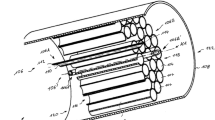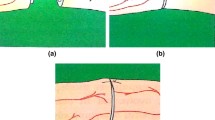Abstract
Nowadays new techniques may help the surgeon in difficult cases of nerve tissue loss: when a gap is produced in a mixed nerve, the use of conduits can be an alternative to nerve grafts, which still represent the “gold standard” for this kind of lesions. We have applied biologic conduits (muscle inside a vein) in more than 40 cases since 1993 with 85% of good functional results for both sensory and mixed nerves up to 5 cm. The advantages of this technique are: 1) all graft material is easily withdrawn in the lesion area and thus is not necessary to perform any new incision; 2) the possibility of reconstructing nerve gaps up to 5 cm avoids secondary damage created by the withdrawal of healthy nerves; 3) the possibility for spontaneous orientation of regenerating nerve fibers is offered as fibers are allowed to search for their final target (chemiotropism).
Furthermore, when the tissue loss is important or the proximal nerve stump is not available, so jeopardizing the possibility of recovery with traditional reconstruction, the use of end-to-side neurorrhaphy has been described to solve the problem. However the use of end-toside neurorrhaphy in the clinical setting for motor recovery remains controversial. In our experience we had satisfying results only in 20% of cases and thus motor reconstruction in the absence of an available proximal nerve may be best handled by nerve to nerve transfers. By contrast we had good results in sensory nerve reconstruction (especially digital nerves) by end-to-side coaptation.
Access this chapter
Tax calculation will be finalised at checkout
Purchases are for personal use only
Preview
Unable to display preview. Download preview PDF.
Similar content being viewed by others
References
Allieu Y, Privat JM, Bonnel F (1984) Paralysis of the brachial plexus. Neurotization by the spinal accessory nerve. Clin Plastic Surg 11: 133–137
Al-Qattan M, Al-Thunayan A (1998) Variables affecting axonal regeneration following end-to-side neurorrhaphy. Br J Plast Surg 51: 238–242
Andreopoulos E, Skoulis TG, Luizzi F et al (1998) Double-labelling technique to trace axonal sprouting after end-to-side neurorrhaphy [abstract]. J Reconst Microsurg 14: 591–599
Battiston B, Lanzetta M (1999) Reconstruction of high ulnar nerve lesions by distal double median to ulnar nerve transfer. J Hand Surg [Am] 24: 1185–1189
Battiston B, Tos P, Cushway T, Geuna S (2000) Nerve repair by means of vein filled with muscle grafts. I. Clinical results. Microsurgery 20: 32–36
Battiston B, Tos P, Geuna S et al (2000) Nerve repair by means of vein filled with muscle grafts. II. Morphological analysis of regeneration. Microsurgery 20: 37–41
Brunelli G, Monini L (1984) Neurotization of avulsed roots of brachial plexus by means of anterior nerves of cervical plexus. Clin Plastic Surg 11: 149–153
Carlstedt T (1995) Spinal nerve root injuries in brachial plexus lesions: basic science and clinical application of new surgical strategies. Microsurgery 16: 13–16
Felici N, Del Bene M, Battiston B, Amadei F (2003) Functional results of end-to-side nerve anastomosis in 39 consecutive patients, Abstracts Volume Second Congress of the World Society for Reconstructive Microsurgery, Heidelberg, p 42
Fornaro M, Tos P, Geuna S, Giacobini-Robecchi MG, Battiston B (2001) Confocal imaging of Schwann-cell migration along muscle-vein combined grafts used to bridge nerve defects in the rat. Microsurgery 21: 153–155
Geuna S, Raimondo S, Nicolino S, Boux E, Fornaro M, Tos P, Battiston B, Perroteau I (2003) Schwann-cell proliferation in muscle-vein combined conduits for bridging rat sciatic nerve defects. J Reconstr Microsurg 19: 119–123
Gu YD, Chen DS, Zhang GM et al (1998) Long-term functional results of contralateral C7 transfer. J Reconstr Microsurg 14: 57–59
Ide C (1984) Nerve regeneration through the basal lamina scaffold of the skeletal muscle. Neurosci Res 1: 379–391
Kalliainen LK, Cederna PS, Kuzon WM (1999) Mechanical function of muscle reinnervated by end-to-side neurorrhaphy. Plast Reconstr Surg 103: 1919–1927
Levi-Montalcini R, Hamburger V (1951) Selective growth stimulating effects of mouse sarcoma on sensory and sympathetic nervous system of the chick embryo. J Exp Zool 116: 321–362
Liu K, Chen LE, Seaber AV, Goldner RV, Urbaniak JR (1999) Motor functional and morphological findings following end-to-side neurorrhaphy in the rat model. J Orthop Res 17: 293–300
Lundborg G (ed) (1988) Nerve injury and repair. Churchill Livingstone, Edinburgh
Lundborg G, Dahlin L, Danielsen N, Zhao Q (1994) Trophism, tropism and specificity in nerve regeneration. J Reconstr Microsurg 5: 345–354
Lundborg G, Longo FM, Varon S (1982) Nerve regeneration model and trophic factors in vivo. Brain Res 232: 157–161
Lundborg G, Rosen B, Dahlin L et al (1997) Tubular versus conventional repair of median and ulnar nerves in human forearm: early results from a prospective, randomized, clinical study. J Hand Surg [Am] 22: 99–106
Lundborg G, Zhao Q, Kanje M, Danielsen N (1994) Can sensory and motor collateral sprouting be induced from intact peripheral nerve by end-to-side anastomosis? J Hand Surg 19B: 277–282
Luo Y, Wang T, Fang H (1997) Preliminary investigation of treatment of ulnar nerve defect by end-to-side neurorrhaphy. Chung Kuo Hsiu Fu Chung Chien Wai Ko Tsa Chih 11: 338–339
Lutz B, Chuang D, Hsu J et al (1998) End-to-side neurorrhaphy: functional and double labelling study in rat upper limb. J Reconstr Microsurg 14: 590–602
Lutz BS, Chuang DC, Ma SF, Wei FC (2000) Selection of donor nerves — an important factor in end-to-side neurorrhaphy. Br J Plast Surg 53: 149–154
Mackinnon S, Dellon AL (1990) A study of nerve regeneration across synthetic (maxon) and biologic (collagen) nerve conduits for nerve gaps up to 5 cm in the primate. J Reconstr Microsurgery 6: 117–121
Mackinnon S, Dellon AL (eds) (1988) Nerve repair and nerve grafting. Surgery of the peripheral nerve. Thieme Medical Publishers, New York
MacKinnon SE (1996) Nerve allotransplantation following severe tibial nerve injury. Case report. J Neurosurg 84: 671–676
Mackinnon SE, Dellon AL (1990) Clinical nerve reconstruction with a bioabsorbable polyglycolic acid tube. Plast Reconstr Surg 85: 419–424
Matsumoto M, Hirata H, Nishiyama M et al (1999) Schwann cells can induce collateral sprouting from intact axons: experimental study of end-to-side neurorrhaphy using a Y-chamber model. J Reconstr Microsurg 15/4: 281–286
McCallister WV, Tang P, Trumble TE (1999) Is end-to-side neurorrhaphy effective? A study of axonal sprouting stimulated from intact nerves. J Reconstr Microsurg 15: 597–603
Millesi H (1981) Interfascicular nerve grafting. Orthopaedic Clin North Am 12: 287–301
Narakas A (1977) The surgical management of brachial plexus injuries. In: Daniel RK, Terzis JK (eds) Reconstructive surgery. Little, Brown, Boston
Oberlin C (1994) Nerve transfer to biceps muscle using a part of ulnar nerve for C5–C6 avulsion of the brachial plexus. J Hand Surg [Am] 19: 232–237
Pagnotta A, Tos P, Fornaro M, Gigante A, Geuna S, Battiston B (2002) Neurotrophins and their receptors in early axonal regeneration along muscle-vein-combined grafts Microsurgery 22: 300–303
Papalia I, Geuna S, Tos PL, Boux E, Battiston B, Stagno d’Alcontres F (2003) Morphological and functional study of rat median nerve repair by means of termino-lateral neurorrhaphy on the ulnar nerve. J Reconstr Microsurg 19(4): 257–264
Risitano G, Battiston B, Coppolino S, Tos P (2001) Risultati clinici sull’utilizzo della tubulizzazione biologica e sintetica nella ricostruzione dei nervi digitali della mano. Riv Chir Mano 38: 28–35
Rovak JM, Cederna PS, Kuzon WM Jr (2001) Terminolateral neurorrhaphy: a review of the literature. J Reconstr Microsurg 7: 615–624
Smith RG, Appel SH (1983) Extracts of skeletal muscle increase neurite outgrowth and cholinergic activity of fetal rat spinal motor neurons. Science 219: 1079–1081
Tarasidis G, Watanabe O, Mackinnon S et al (1997) End-to-side neurorrhaphy resulting in limited sensory axonal regeneration in a rat model. Ann Otol Rhinol Laryngol 106: 506–512
Tarasidis G, Watanabe O, Mackinnon S et al (1998) End-to-side neurorrhaphy: a long term study of neural regeneration in a rat model. Otolaryngol Head Neck Surg 119: 337–344
Tarasidis G, Watanabe O, Mackinnon S, Strasberg SR, Haughey BH, Hunter DA (1988) End-to-side neurorrhaphy: a long term study of neural regeneration in a rat model. Otolaringol Head Neck Surg 119: 337–341
Tos P, Battiston B, Geuna S et al (2000) Tissue specificity in rat peripheral nerve regeneration through combined skeletal muscle and vein conduit grafts. Microsurgery 20: 65–71
Varon S, Adler R (1981) Tropic and specifying factors directed to neuronal cells. Adv Cell Neurobiol 2: 115–163
Viterbo F, Trindade JC, Hoshino K, Mazzoni Neto A ( 1994) End-to-side neurorrhaphy with removal of the epineurial sheath: an experimental study in rats. Plast Reconstr Surg 94: 1038–1047
Viterbo F, Trinidade JC, Hoshino K, Mazzoni A (1992) Lateroterminal neurorrhaphy without removal of the epineural sheat: experimental study in rats. Sao Paulo Med J 110: 267–275
Waller A (1850) Experiments on the section of glossopharyngeal and hypoglossal nerves of the frog, and observations of the alterations produced thereby in the structure of their primitive fibers. Philos Trans R Soc London (Biol) 140: 423–429
Weber RA, Breidenbach WC, Brown RE, Jabaley ME, Mass DP (2000) A randomized prospective study of polyglycolic acid conduits for digital nerve reconstruction in humans. Plast Reconstr Surg 106: 1036–1045
Yamauchi T, Yajima Y, Tamai S et al (2001) Neurohistochemical analysis of regeneration in rat peripheral nerve after end-to-side neurorrhaphy. J Orthop Sci 6: 82–87
Yüksel F, Karacaolu E, Güler M (1999) Nerve regeneration through side-to-side neurorrhaphy sites in a rat model: a new concept in peripheral nerve surgery. Plast Reconstr Surg 104: 2092–2099
Zhang Z, Soucacos P, Bo J, Beris AE (1999) Evaluation of collateral sprouting after end-to-side coaptation using a fluorescent double labelling technique. Microsurgery 19: 281–286
Author information
Authors and Affiliations
Editor information
Editors and Affiliations
Rights and permissions
Copyright information
© 2007 Springer-Verlag
About this paper
Cite this paper
Battiston, B., Tos, P., Conforti, L.G., Geuna, S. (2007). Alternative techniques for peripheral nerve repair: conduits and end-to-side neurorrhaphy. In: Millesi, H., Schmidhammer, R. (eds) How to Improve the Results of Peripheral Nerve Surgery. Acta Neurochirurgica Supplementum, vol 100. Springer, Vienna. https://doi.org/10.1007/978-3-211-72958-8_10
Download citation
DOI: https://doi.org/10.1007/978-3-211-72958-8_10
Publisher Name: Springer, Vienna
Print ISBN: 978-3-211-72955-7
Online ISBN: 978-3-211-72958-8
eBook Packages: MedicineMedicine (R0)




